Sketchup is Inacurrate???
-
Sorry Jeff, it's not me indulging in semantics ...it's you. The Follow Me Tool is most definitely an extrude tool, not a rotate tool. I've already pointed out the single instance in which it can be used as a form of rotate tool...a complete 360 degree lathe....and page after page of this thread has been devoted to various people zeroing in on that one specific aspect and complaining about the fact that you can't downsize it to a 180 or 90 degree turn. You can't...it's 360 or nothing.
You know as well as I do that any extrude tool worthy of the name can extrude along a path, not just the contrived example you posted...which is more akin to Vector P/P...but along a curved path, not a single vector. It is, in fact, a loft operation. Did you construct it manually, or did you simply use Loft along Path?
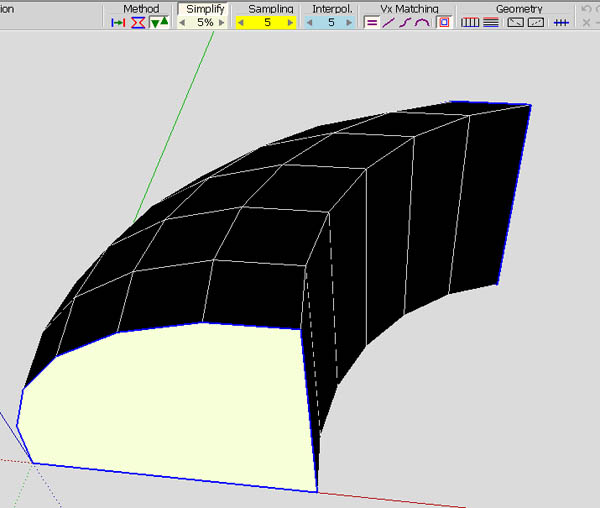
Follow Me has an infinity of uses beyond its very narrow use covered in these ages. You can't possibly claim it's any kind of revolve tool when it's used to extrude a profile along paths like these hydraulic pipes. Of course it's an extrude tool...but your definition of what an extrude tool ought to do would have it maintaining the orientation of the original circle as it follows the path around those bends. That would produce a totally ludicrous result.
Any kind of Rotate Tool would require you to define the axis of rotation and then specify the degree of rotation about that axis...producing exactly what Olav would like to see; and exactly what you have to do when 'programming' a dynamic door component, for example. We don't have that...because we don't have a Rotate Tool. -
@alan fraser said:
Sorry Jeff, it's not me indulging in semantics ...it's you. The Follow Me Tool is most definitely an extrude tool, not a rotate tool.
it's neither..it's a sweep tool..
i dunno.. i'm just comparing to what i see in other apps which have all three tools.. extrude, sweep, and revolve.. (maya, autocad, rhino, cheetah, probably max, solidworks, etc..)and follow me matches sweep.
extrude does what i showed above..
revolve does what it sounds like it would dopush/pull is an extrude tool.. a simple one.
[edit] as in.. i'm definitely not claiming to be some sort of voice of authority on the definition of modeling tools.. i'm just saying what i see in other places.. but if you go to another app and try to extrude a profile along a path expecting a followme type deal, you're probably not going to like the results.. you'd want to do a sweep instead..
-
I'd say, some plugin developer has lots of meat for a at least a couple of commercial plugins here.
(Don't look at me - I've got too many projects already.)
-
@thomthom said:
I'd say, some plugin developer has lots of meat for a at least a couple of commercial plugins here......
Imo it would be a waste of time and effort to create an offset tool for segmented true arcs unless when dealing with tangent connections. Otherwise you'll be asking for 1+1=3 at connections arc<>connecting geometry. For 'there's no way you can keep an equal number of full segments in both the original arc and its offset. Only with true arcs where both have an infinite number of segments.
If however you use a segmented arc with true offset in a "not tangent connection to other geometry" situation, you'll be left with three choices:- you'll have to accept cut off and/or extended segments in the new offset (segmented true arc) at either end. Then what in a next offset step? For you only have a segmented true arc with less whole segments covering a smaller angle. The ends are no longer of use. In between, the corresponding vertices distances will be equal to the offset. (this option might have a chance)
- Full equal segments? You'll be forced to redraw the arc from intersections of both miter lines and the true offset as if it were NOT a segmented arc. So then you’ll have an arc with equal number of segments but completely useless. Its midpoint appears to be not coinciding. Its vertices are not on the radii running to the vertices of the original arc. They just do not lign up.
- The new offset (segmented true arc) can't be properly connented to the rest of the offset when you do want both arcs to cover the same angle.
Maybe that’s why the developers didn’t and don’t want to burn their fingers on this issue. The more covenient way is how segmented arcs are dealt with now.
Not until we have true (I mean true) arcs, this whole problem will be over.If its about just only offsetting the segmented arc as if it were a true arc, that is quite easy with SU's native tools. And I understand there's already TIG's plugin to do so. Integrating the result in the rest of the geometry? .... See above 1) to 3).
-
As you already know that FollowMe treats all paths as a set of co-vertexed edges, ignoring any 'arc-ness', then it's a little ingenuous to illustrate it doing just that as if it's a surprise.
Your original arc is not a 90 degree swept quarter circle. If you rotate-copy it at 90 degrees x3 about the center-point they'll overlap.
The initial face orientation must be guessed but I suspect it wasn't perpendicular and thereby hangs the distortion.
If you want a true 'lathed' result of sweeping a face around an axis by say 90 degrees then there are plenty of tools to do this. FollwMe just isn't one of them. "When the only tool you have is a hammer everything starts to look like a nail..." Get a screwdriver when you need it!
The illustrated version made using my ExtrudeEdgesByLathe works fine.
It also shows the discrepancy between a true sweep and your inner arc...
If you want a form that actually uses that 'off' inner arc then other tools, like CurviLoft or my own EEbyRails tools will do this relatively simply too...
-
Lathed hemisphere using Follow Me. I rest my case. SU thinks it's an extrusion; the developers seem to think it's an extrusion.
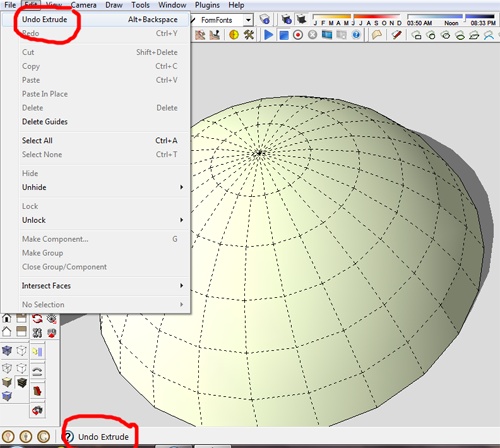
I absolutely agree. Thom...especially an intuitive Revolve/Lathe tool that works pretty much like Follow Me; and an Offset tool that accurately offsets vertices on a curve, but edge perpendiculars on everything else.
Having said that, we already have tools that do at least some of what is being asked for. This is Olav's last example...but done using Curviloft, not Follow Me. Seen from underneath, all those radii (including the end ones) are exactly the same length.
{Edit} I see TIG beat me to some of this.
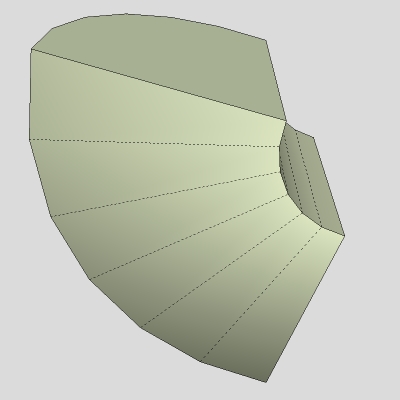
-
@alan fraser said:
Lathed hemisphere using Follow Me. I rest my case. SU thinks it's an extrusion; the developers seem to think it's an extrusion.
actually, they seem to think it's a do-everything tool (even though it only does one thing good
 ) (edit- well, it doesn't do any of them good in all situations)
) (edit- well, it doesn't do any of them good in all situations)http://www.sketchup.com/product/features.html
@unknownuser said:
Follow Me: Create complex extrusions and lathed forms
You use SketchUp's innovative, do-everything Follow Me tool to create 3D forms by extruding 2D surfaces along predetermined paths. Model a bent pipe by extruding a circle along an L-shaped line. Create a bottle by drawing half of its outline, then using Follow Me to sweep it around a circle. You can even use Follow Me to round off (fillet) edges on things like handrails, furniture and electronic gadgets.
so i guess it lathes, sweeps, & extrudes

-
@alan fraser said:
and an Offset tool that accurately offsets vertices on a curve, but edge perpendiculars on everything else.
or, saying the same thing in a different way..
it would only offset vertices.. if it's an endpoint of an edge, it moves perpendicular ..if it's a vertex of a curve, it moves on a vector which bisects the angle of adjacent vertices.. (though this would only truly work on arc, it's a decent start on how a curve should be offset..then all the vertices are connected with lines (lengthened or shortened as need be)
if there's an edge connected to a curve, the edge's endpoint overrides the curve.. (i.e.- the end of an edge offset when connected to a curve will not be lengthened&mitered.. it just stops at the edge then the adjacent curve's segment meets it there)
the only complication i see is how to deal with the raw end of a curve which only has one adjacent line instead of two..
@unknownuser said:
Having said that, we already have tools that do at least some of what is being asked for. This is Olav's last example...but done using Curviloft, not Follow Me. Seen from underneath, all those radii (including the end ones) are exactly the same length.
thing is, (again, as i see it).. everything is only a 1 level fix when in reality, it should be at least 2 levels deep..
ie- it's not the fact that sketchup can't offset properly which is a huge issue.. the problems come from geometry which is being built on top of that bad offset..so it should be a 2 level fix.. sketchup itself fixes the offset then all subsequent plugins now work off that solid foundations (for instance, in the case of something like jpp, the edges and hidden geometry of a surface would have the smarts of a proper offset tool within sketchup itself.. so when you jointpushpull it, you can get true surface offsets..
(not explained so well, i agree.. maybe i'll come up with a better example later)
-
Very few such complex tools work in more than a limited number of situations, Jeff. You might think that asking for an Offset Tool that simply offsets from vertices in the way you describe would do the trick...but it doesn't.
@unknownuser said:
it would only offset vertices.. if it's an endpoint of an edge, it moves perpendicular ..if it's a vertex of a curve, it moves on a vector which bisects the angle of adjacent vertices.. (though this would only truly work on arc..
As you point out, this would only work on arcs. But it's worse than that...it would only work on convex arcs. Try it on a concave arc...of the type commonly found in framing, coving etc. and what you get is this.
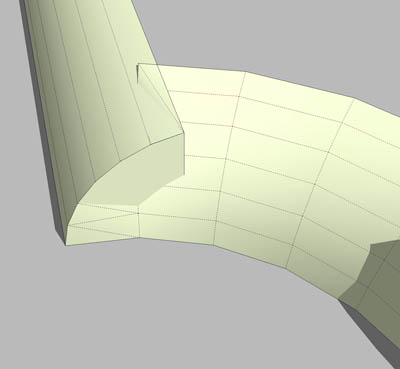
This is precisely why I accept that many such things are only 1 level deep; and don't keep bitching that any particular tool isn't a magical cure-all.
-
@alan fraser said:
As you point out, this would only work on arcs. But it's worse than that...it would only work on convex arcs. Try it on a concave arc...of the type commonly found in framing, coving etc. and what you get is this.
that looks right i think.. you just haven't trimmed and/or extended the intersections..
-
Hello Jeff, did you delete a post or I'm crazy?
-
-
Was it?
You are sometimes (often) a pebble in the shoe, but this remind us we are just humans.
Hang on.
-
So far the only way I have done shapes, like the last shown, was by building them by hand.
That way I am sure there is no weird bulge or any other unexpected result.
It is nowhere stated by the developers that one should not use the follow me tool, at least I did not see any warning.
This is the promise from the Sketchup web site:
@unknownuser said:
Follow Me: Create complex extrusions and lathed forms
You use SketchUp's innovative, do-everything Follow Me tool to create 3D forms by extruding 2D surfaces along predetermined paths. Model a bent pipe by extruding a circle along an L-shaped line. Create a bottle by drawing half of its outline, then using Follow Me to sweep it around a circle. You can even use Follow Me to round off (fillet) edges on things like handrails, furniture and electronic gadgets.
No warnings stating that there are problems and unexpected results.
Edit: oh I just saw Jeff had quoted the above statement already, sorry for the repeat.
-
-
+1, great shapes to deal with plywood and a saw.

-
but if people realized i actually really do need these abilities from a software, and that i'm not just making things up or being theoretical/hypothetical, then there wouldn't be anything to argue about

(really though.. i reread that post a little bit after posting it and saw how it could get skewed into something it wasn't without getting across the point i was trying to make so i just deleted it.. )
-
Now the big question does a polygon / box modeler capable to simulate a true
arc / circle without to drive crazy the ruby coder!

-
@unknownuser said:
Now the big question does a polygon / box modeler capable to simulate a true
arc / circle without to drive crazy the ruby coder!
good question.. because i don't actually know what it's like to code.. so hey, maybe what i wish sketchup would do is in fact impossible in such an app..
my stance is based off what i think or assume is possible, even in a polymodeler.. in my head i'm like "wtf.. why can't sketchup be a little smarter in this scenario ?" or "i see other apps (nurbs) that handle this situation with zero problem what so ever"..
but seriously, maybe sketchup and the like are in fact dumb and must remain dumb? it's just that i can't logically come to that conclusion and nothing said by anyone else has led me to believe it's not possible.. it seems more that the majority of people, including the developers, simply don't care about upping it's intelligence..
does violette mean purple?
.
-
@desertraven said:
This is the promise from the Sketchup web site:
@unknownuser said:
Follow Me: Create complex extrusions and lathed forms
You use SketchUp's innovative, do-everything Follow Me tool to create 3D forms by extruding 2D surfaces along predetermined paths. Model a bent pipe by extruding a circle along an L-shaped line. Create a bottle by drawing half of its outline, then using Follow Me to sweep it around a circle. You can even use Follow Me to round off (fillet) edges on things like handrails, furniture and electronic gadgets.
No warnings stating that there are problems and unexpected results.
But that's quite obviously the sales pitch, not Technical Support. When have you EVER seen caveats included in a sales pitch...except on some cigarette or financial services ads, where it is a legal requirement.
There is nothing in the paragraph above that is not true. You can even still use the Follow Me Tool to achieve an absolutely accurate version of such a lathed shape that isn't a 'Total Screw Up'. You can also use TIG's EE by Lathe or Fredo's Curviloft to achieve exactly the same absolute precision. So there is clearly nothing wrong with the background calculations taking place within the core program. The fault lies with the person using those tools in an inappropriate manner.
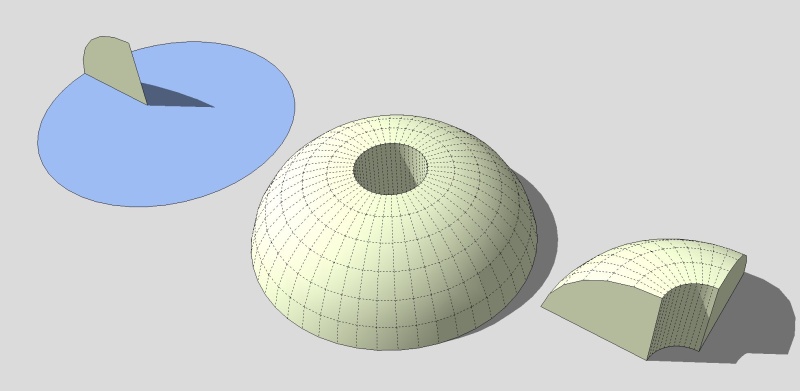
SketchUp can be learnt within hours...but only the broad sweep of it, used for general modelling. Anyone wanting to achieve absolute precision in all circumstances is going to have to put the time in, as they would on any other software. It specifically mentions circle in that blurb above. As I've already stated a couple of times, that is the one specific instance that the Extrude Tool can be used as an accurate Lathe Tool.
Having seen that it doesn't work on anything less than a circle, I see no sense in continuing to try to knock a square peg into a round hole by using it on smaller arcs, then complaining that it doesn't work properly. That's a classic case of the poor workman blaming the tools. It does work...if you use it properly.
This is not complacency, it's simply being realistic. I can sympathise with Jeff's demands for stuff like an Offset Tool that works in a consistent way with the Circle and Arc Tools. I would like to see, for instance, a circle...when extruded to a simple, unedited cylinder...transfer its properties to that cylinder. I know we can now still edit the radius (which was not always the case) but how about still being able to edit the number of segments? We're only talking about a cylinder here, not some coiled length of hosepipe.
I do think that some of Jeff's expectations are probably unacheivable. A polygon modeller is not a NURBS modeller...and never will be.One of the main tenets of SU development has always been that it ought to be able to play nicely with other software. So if you absolutely require something (like precisely intersecting arcs) that can only be modelled in NURBS (or a 2D bezier drafter) then use that and import them when done. If I want to do proper UV mapping, I use TIG's proxy script to talk to UU3D and do it there.
On the other hand, I don't have any sympathy with people using the existing software inappropriately; and then blaming the software. These arguments about SU being able to handle every conceivable contingency as opposed to the KISS approach have been raging for at least a decade. I can remember all the desperate pleas for a raytracer to be included (before we had Podium or anything else)...I had to export to Vue and do it there. The dev team resisted; and now we have more renderers than you can shake a stick at, without further complicating the basic GUI or the usability of the program.
Getting back to the title of the thread. Yes, there can be some inaccuracies (due mostly to SU not handling true curves) i don't know if they can ever be entirely resolved; but I'm hoping the devs will at least try to push the envelope. But, in my experince, most inaccuracy lies between chair and keyboard.
Advertisement







